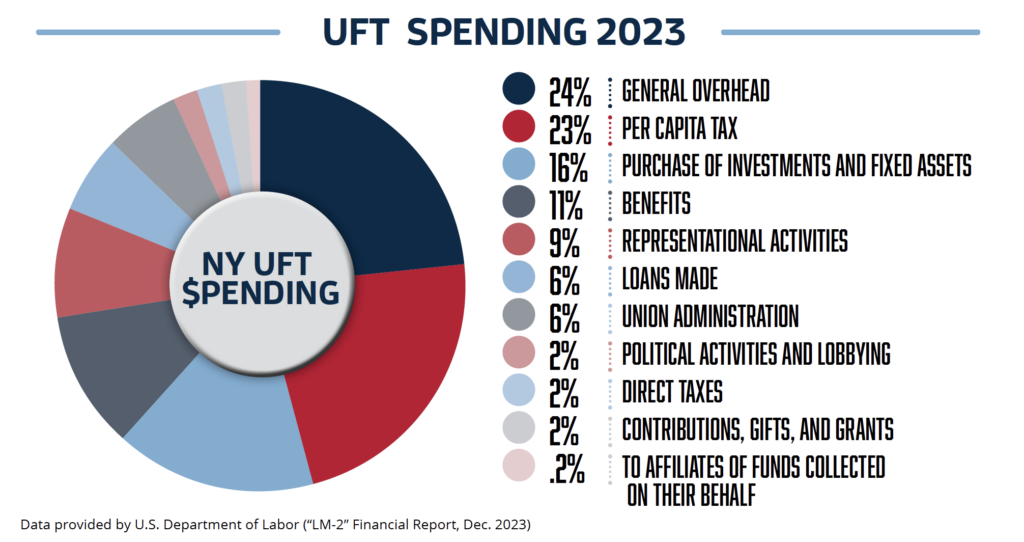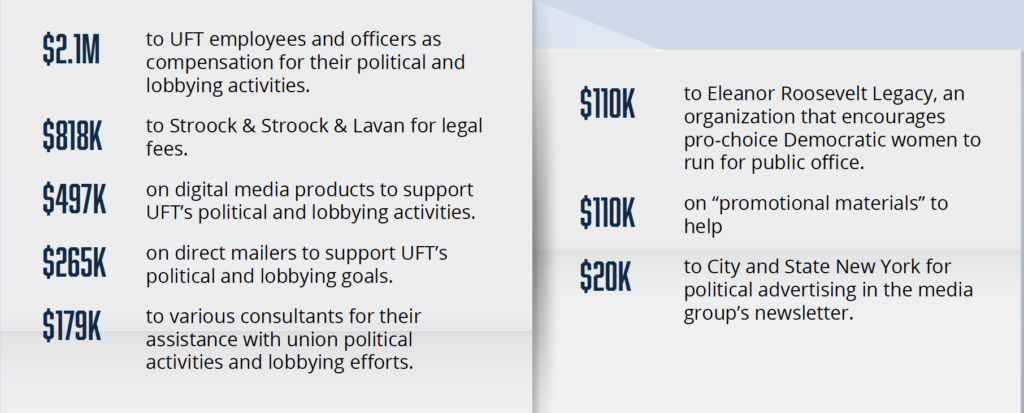The United Federation of Teachers (UFT) represents roughly 190,000 teachers in New York City’s Public Schools. UFT is affiliated with American Federation of Teachers (AFT), the nation’s second-largest teachers’ union and New York State United Teachers (NYSUT). As a union that represents public and private sector employees, UFT files a LM-2 financial disclosure form with the United States Department of Labor. So, what does this filing reveal about the union? Representing membership in collective bargaining, grievance procedures, or in other workplace matters is the primary responsibility of a union.
However, UFT spent very little money on representing its 190,415 members. During the latest reporting period, which covers August 1, 2022 through July 31, 2023, spending on representational activities accounted for a mere 9.4 percent of all expenditures.
While UFT has failed to spend on member representation, its membership has remained relatively steady. Since 2021, UFT has lost 421 members. Though membership has not significantly decreased, UFT’s revenue from membership dues has. In 2021, UFT collected $179.7 million in dues compared to $174.7 million collected in 2023. While UFT does not disclose the amount it charges in membership dues, it has seen an increase in retired members (who do not pay full dues, if any dues at all) and a decrease in active members, which explains why it is collecting less dues revenue.
While dues revenue is down, UFT’s financial position has significantly improved since 2021. In 2021, UFT held over $230 million in liabilities, most of which came from UFT employee pension and other retirement-related obligations. At that time, UFT was more than $43 million in the red. Now, in the 2023 reporting period, UFT has paid down its employee retirement liabilities and holds over $38 million in net assets. During the 2023 reporting period, UFT acquired an operating lease, which significantly increased both assets and liabilities.
Rather than representing membership, UFT’s primary goal was sustaining union operations. Operating expenses accounted for nearly 80 percent of all expenditures. In 2023, operating expenses included general overhead expenses (23.7 percent), per capita tax paid to affiliated unions (23.4 percent), purchasing investments and fixed assets (16.1 percent), UFT employee benefits (10.7 percent) and administration costs (5.7 percent). Compensation for UFT executives is an important part of operating a union. UFT President Michael Mulgrew made $349,336 during the last reporting period, over five times the average salary of a New York City public school teacher.

UFT Political Spending
According to federal law, member dues can be used for a variety of political activities, such as issue advocacy, get-out-the-vote drives, election mailers, lobbying, and public marketing campaigns. Like most unions, UFT spends membership dues money on political activities and lobbying. The union reported spending $4.5 million of members’ dues on political activities and lobbying.
The Janus v. AFSCME Supreme Court decision relieves nonmembers from the obligation to pay any dues or fees to the union as a condition of public employment. However, for teachers who remain UFT members, Janus changes nothing about how union dues are spent: they are still routinely used for political purposes. During the latest reporting period, UFT reported spending:

UFT is politically active in other ways too. In the 2022 election cycle, UFT endorsed all four Democratic candidates for statewide office. The union also endorsed 179 Democrats out of the 212 state legislature seats up for election. Additionally, the union makes recommendations for federal races, recommending members vote for Chuck Schumer in the United States Senate race and all 26 Democratic candidates running for the United States House of Representatives.
As previously mentioned, the UFT is associated with NEA, NYSUT, and AFT. Given that over one quarter of UFT membership dues are transferred to affiliates, members should be aware of how those affiliates spend the dues money they receive. For more information on UFT’s affiliates, see the below links: